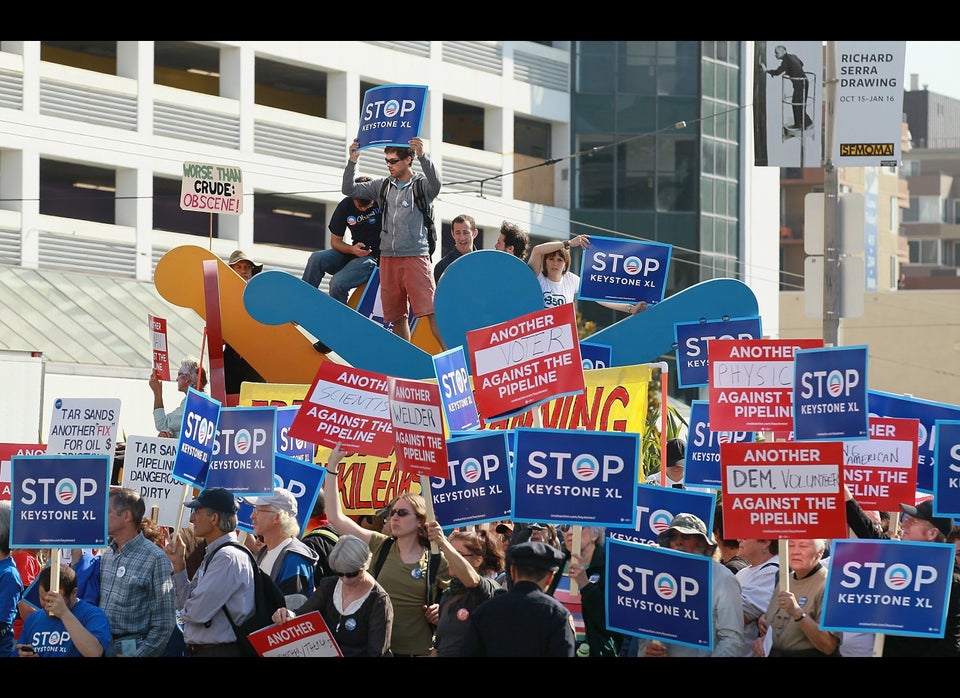
By Cezary Podkul
NEW YORK, Dec 13 (Reuters) - Continental Resources, one of the companies that has committed to ship crude on TransCanada Corp's proposed Keystone XL pipeline, now says the controversial pipeline is no longer needed.
Continental has signed on to ship some 35,000 barrels of its own oil from the Bakken field of North Dakota on the 1,179-mile, $5.4-billion Keystone XL line. But construction of the pipeline has been delayed for years as TransCanada has sought regulatory approvals, and Continental has since turned to railroads to get its crude to oil refineries.
Harold Hamm, chief executive of the independent oil producer, told Reuters that his company and the U.S. oil industry in general are no longer counting on Keystone XL.
Oil companies have been strong advocates of Keystone in order to help alleviate oil supply bottlenecks, but Hamm's remarks raise the question of whether regulatory delays have eroded the industry's enthusiasm for the line, which has faced aggressive resistance from environmentalists.
When asked whether Keystone XL is still needed, Hamm said "not for our Bakken (crude). And is it needed for the industry? I don't think so ... not in the U.S."
"Rail has been a big factor and, you know, proven to be a very effective way" (of getting Continental's crude to market), he said on the sidelines of the Platts Global Energy Outlook Forum in New York on Thursday.
Continental now ships 90 percent of its crude oil by railcar, Hamm said. Rail transport can be more expensive, but it allows shippers more flexibility on where the crude is shipped.
"It may be several years yet, you know, before you find out if it (Keystone XL) is going to be built," Hamm said. "It's no way to run your business."
Keystone XL's developer, Canadian pipeline giant TransCanada, said the line has broad support, and there is a waiting list of customers interested in securing capacity on the line. Keystone XL should be operational two years after TransCanada receives a U.S. permit to complete it.
"Rail may be a flexible, short-term solution but pipelines and Keystone XL in particular are more efficient from a safety, environmental and economic perspective," said company spokesman Shawn Howard.
"It's also important to look at the whole U.S. energy picture, not just the production coming out of one field or from one company," he said.
Howard declined comment on TransCanada's contract with Continental, citing confidentiality.
TransCanada first applied for a U.S. permit for Keystone XL in 2008, but the line remains under review by the Obama administration.
If built, it would connect the Alberta oil sands in Canada with U.S. refiners and provide an alternative route for more crude to reach U.S. Midwest and Gulf Coast markets.
To be sure, Continental's view on Keystone may have little or no effect on the line's prospects. Most of the crude that would move on Keystone XL - whose capacity would be 830,000 barrels per day - would originate in Canada.
Continental is one of a handful of U.S. producers to sign up to use the line. Their commitments are small relative to Canadian oil sands shippers, who are counting on Keystone as a vital outlet for their crude. Canadian crude is now heavily discounted versus U.S. crudes due to scarce transportation options to get more of it to end-users.
The majority of the proposed pipeline route - some 850 miles - is in the United States, crossing Montana and South Dakota en route to Steele City in southern Nebraska, where connections are available to the Gulf Coast via Cushing, Oklahoma and to the Midwest.
A southern portion of TransCanada's Keystone network - known as the Gulf Coast Project, from Oklahoma to the Texas Gulf Coast - has already been built, and is expected to begin operating next month. Unlike the international Keystone XL, that line didn't require a U.S. State Department permit.
Environmental groups have opposed Keystone XL on grounds that it would allow higher production of carbon-intensive Canadian oil sands crude. Yet concerns have also arisen about the safety of crude transport by rail, a booming industry. This year, crude train derailments have caused disasters in Quebec and rural Alabama.
The largest U.S. railroads will likely transport about 400,000 carloads of crude oil in 2013, versus just 9,500 in 2008, according to estimates from the Association of American Railroads.
In 2010, Continental and other companies persuaded TransCanada to add a $140 million extension spur to Keystone XL to pick up and transport U.S.-produced Bakken crude beginning in 2014.
Before TransCanada agreed to ship U.S. crude down Keystone XL, Hamm had lobbied in 2009 against the pipeline, arguing that it could flood the U.S. Midwest with a glut of cheap Canadian crude, hurting independent oil producers such as Continental.
Bakken producers have seen growing demand in recent years from U.S. refiners eager to lower their costs by buying the region's attractively priced light, sweet crude. That's made the opportunity cost of waiting for the pipeline even higher.
It isn't clear whether Continental will ship any crude on Keystone XL if it is eventually built. So far, Continental has not sought to back out of its contract as a shipper on the line, Hamm said.

